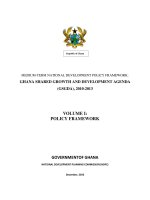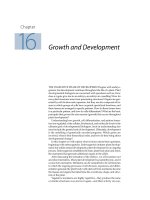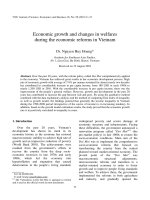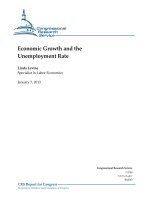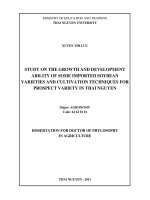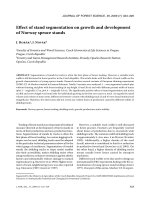Economic growth and development
Bạn đang xem bản rút gọn của tài liệu. Xem và tải ngay bản đầy đủ của tài liệu tại đây (15.22 KB, 5 trang )
Economic growth and development
The economic development of a country or society is usually associated with
(amongst other things) rising incomes and related increases
inconsumption, savings, and investment. Of course, there is far more to
economic development than income growth; for if income distribution is highly
skewed, growth may not be accompanied by much progress towards the goals
that are usually associated with economic development.
characteristics in equal measure. And, some of you might even question the
presence of certain items in the above list, pointing perhaps to countries (or
regions within them) in which, for example, crime and employment levels
appear to be quite high, or highlighting the fact that not everyone has access to
good public services, housing and so on. Some of these points are clearly open
to debate. For instance crime levels in the rural areas of many developing
countries where most people live are often much lower than in some of the
urban population centres of developed countries. Nonetheless, the above list is
probably fairly indicative of the characteristics that distinguish countries that
are economically developed from those that are not.
Economic growth
From the answer to the previous question you will have noticed that the listed
characteristics once again say more about goals than the processes or
mechanisms for achieving them. So what drives a country towards achieving
these goals? The orthodox view, espoused by most governments, most major
international organisations, and the economists that advise them, is that a big
part of the answer lies in economic growth.
However, economic growth can follow many different paths, and not all of
them are sustainable. Indeed, there are many who argue that given the finite
nature of the planet and its resources, any form of economic growth is
ultimately unsustainable. We shall leave these debates for later. For now let us
look at what exactly economic growth is and how it is measured.
Economists usually measure economic growth in terms of gross domestic
product (GDP) or related indicators, such as gross national
product (GNP) or gross national income (GNI) which are derived from
the GDP calculation. GDP is calculated from a country's national accounts
which report annual data on incomes, expenditure and investment for each
sector of the economy. Using these data it is possible to estimate the total
income earned in the country in any given year (GDP) or the total income
earned by a country's citizens (GNP or GNI).
GNP is derived by adjusting GDP to include repatriated income that was
earned abroad, and exclude expatriated income that was earned domestically by
foreigners. In countries where inflows and outflows of this sort are significant,
GNP may be a more appropriate indicator of a nation's income than GDP.
There are three different ways of measuring GDP
•
the income approach
•
the output approach
•
the expenditure approach
The income approach, as the name suggests measures people's incomes, the
output approach measures the value of the goods and services used to generate
these incomes, and the expenditure approach measures the expenditure on
goods and services. In theory, each of these approaches should lead to
the same result, so if the output of the economy increases, incomes and
expenditures should increase by the same amount.
Figures for economic growth are usually presented as the annual percentage
increase in real GDP. Real GDP is calculated by adjustingnominal GDP to
take account of inflation which would otherwise make growth rates appear
much higher than they really are, especially during periods of high inflation.
Short-term versus long-term growth
A distinction needs to be made between short-term growth rates and longer
term ones. It is quite normal for short-term growth rates to fluctuate in line
with the business cycle. This can be seen in the two figures in 1.2.1
representing GDP growth in the US between 1930 and 2003.
According to the measures of GDP and growth shown here, growth in recent
decades has fluctuated between zero and 5% per annum. Clearly, based on
long-term trends, growth rates exceeding 5% (as measured here) would seem to
be unsustainable. When politicians are talking about sustainable growth they
are often referring to macroeconomic concerns relating to the cycle of boom
and bust. An economic boom involves high growth rates and is often
accompanied by rising inflation. It is often followed by a period of lower
growth rates and recession ('bust'). Sustainable growth in this context relates to
stable growth rates that even out the fluctuations in the business cycle, thus
avoiding high peaks and the large troughs associated with recessions. Note that
this is different from the issues that environmentalists typically focus upon
when they discuss the sustainability of economic growth. We shall say more on
this later.
Relationship between growth and development
Do high levels of GDP necessarily correspond with high levels of
development? Not necessarily. It is not aggregate GDP that is important, but
GDP per capita. Countries like China and India have much higher levels of
GDP than, say, Singapore, New Zealand or Belgium, but few would suggest
that the latter are economically less developed than the former.
Certainly, statistics reveal that the most developed countries are those with
the highest GDP per capita (see Easterly 2002). Clearly, though, GDP per
capita doesn't tell the whole story. GDP per capita is calculated by dividing
GDP by the population. It says nothing about how incomes are distributed or
spent. Growth in GDP per capita could result from growth in the incomes of
richer groups in society, with incomes of poorer groups remaining largely
unchanged. It coincides with spending patterns that are skewed towards the rich
and which exclude the needs of the poor. It doesn't necessarily follow that
growth in per capita GDP will lead to a reduction in poverty or to broader
social and economic development. Indeed, there are those who argue, rightly or
wrongly, that in many countries economic growth is associated with increasing
levels of poverty, rather than the reverse.
The relationship between economic growth and poverty is a hotly debated
topic, about which people are very divided. Some people highlight the negative
effect of growth on low income groups, stressing the need for new
approaches to economic development that will allow the poor to benefit more
from economic growth than they do at present. Others are more sanguine,
believing that the benefits of current models for growth will eventually
'trickle down' to poorer groups in society, if they are not already doing so.
Much of the debate in this area revolves around the values and ideals of
those engaged in it, as well as the different theories on the subject. It also
hinges upon interpretations of the empirical evidence. Poverty and income
distribution are hard to measure, especially in developing countries where the
capacity to gather and analyse data is often very weak. Consequently, the
strength of the statistical relationship between growth and poverty remains
the subject of debate. There is also controversy about the mechanisms by which
economic growth may reduce poverty, the timing of these and the policy
implications.
GDP and purchasing power parity
An additional problem with GDP as a measure of development occurs when
one compares per capita GDP across countries. This problem arises because
one US dollar in the United States or Europe, for example, does not buy the
same amount of goods and services as it would do in, say, Africa or Asia. For
many goods and services one dollar will purchase significantly more in a
developing country than it will in a developed one. To overcome this difficulty,
economists often use purchasing power parity (PPP) dollars when
making cross-country comparisons of GDP. These are dollars that are
adjusted to account for the differences in purchasing power between different
countries.
Human development index
The weaknesses inherent in the use of GDP as a measure of development has
led to the creation of other measures. The most well known of these is the
human development index (HDI) published on a regular basis by The United
Nations Development Programme (UNDP) in itsHuman Development Report.
The HDI is a composite index that rates countries according to their overall
performance in relation to three criteria
•
life expectancy
•
education
•
per capita GDP (using PPP dollars)
As noted earlier, these are related to fundamental freedoms to live and to
participate in society.

